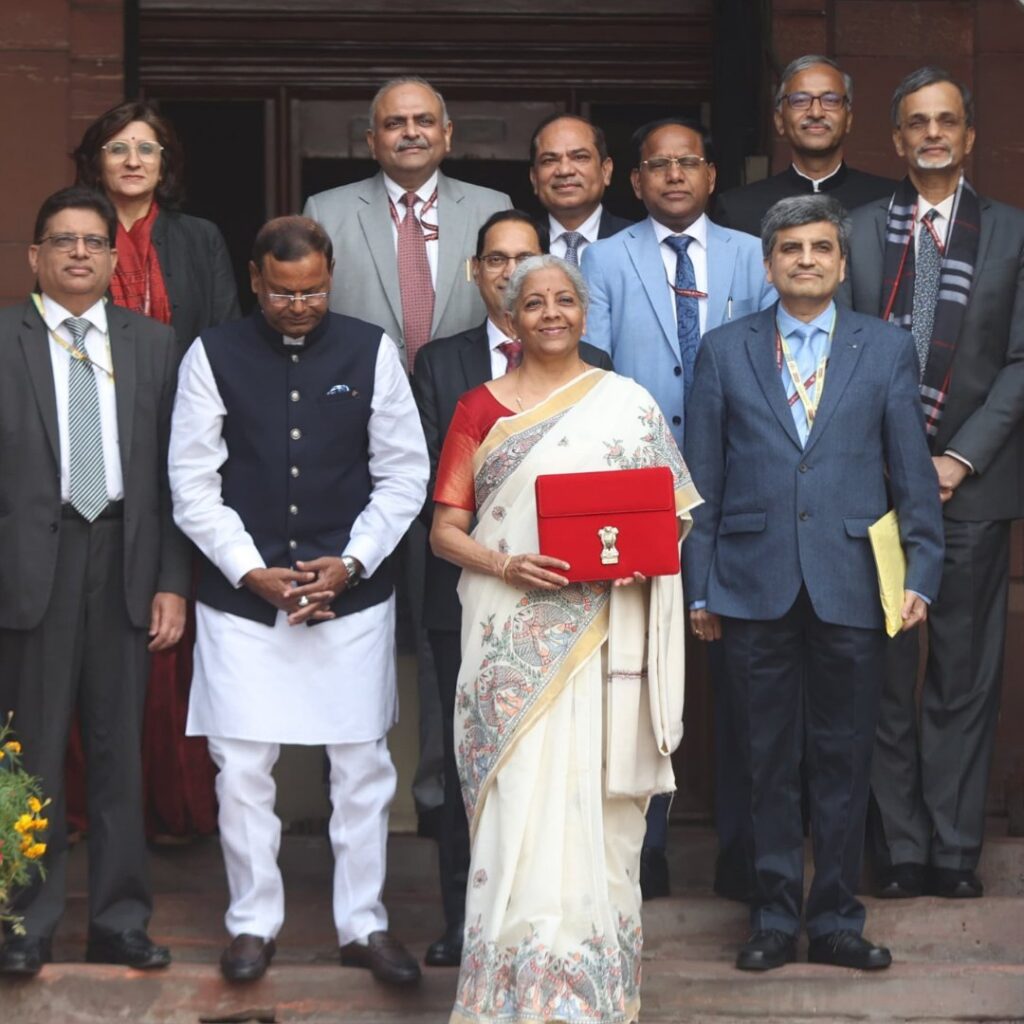By The Sampadak Express
Union Finance Minister Nirmala Sitharaman, breaking away from the colonial-era tradition of carrying a Budget briefcase, once again opted for a modern, yet traditional approach by using a digital tablet encased in a ‘bahi-khata’ style pouch to present the Union Budget 2025 on Saturday, February 1. This marks her eighth consecutive Union Budget presentation since taking office.
Sitharaman, who made history as India’s first full-time woman finance minister, is continuing her break from past conventions, which began in July 2019 when she discarded the customary leather briefcase and instead carried Budget documents in a red cloth folder. This bold step set the stage for her subsequent years of presenting the Budget in an increasingly digital manner.
A Step Towards Modernization with Tradition
In her eighth Union Budget presentation, Sitharaman continued her practice of using a digital tablet to carry her speech and Budget documents, a method she introduced after breaking with tradition in 2019. The digital tablet, securely placed inside a red pouch adorned with the golden national emblem, symbolizes the government’s push towards a more modern and paperless way of presenting the Union Budget.
On the morning of the Budget presentation, Sitharaman was draped in a stunning off-white handloom silk saree, featuring intricate fish-themed embroidery and a golden border. She posed outside her office at the North Block with her team of officials for the traditional ‘briefcase’ photo-op before heading to meet President Droupadi Murmu. After the meeting with the President, she proceeded to Parliament to present the much-anticipated Union Budget 2025.
The Historical Shift: Breaking Colonial Tradition
Sitharaman’s choice to carry the Budget documents in a red cloth folder instead of a briefcase marked a significant departure from the colonial-era practice. The use of a briefcase to carry the Budget documents is a British legacy, dating back to the 18th century when the Chancellor of the Exchequer in the UK was tasked with ‘opening the budget’ while presenting his annual statement. In 1860, British budget chief William E Gladstone used a red suitcase with the Queen’s monogram to carry his papers. The tradition of the ‘budget case’ evolved over the years, with British finance ministers using briefcases of varying colors to carry their documents.

In India, the tradition of carrying a briefcase was adopted by the country’s first finance minister, RK Shanmukham Chetty, who used a leather portfolio to present the first Budget in 1947. Over the decades, different finance ministers, including TT Krishnamachari, Jawaharlal Nehru, Manmohan Singh, and Piyush Goyal, adhered to this tradition. Piyush Goyal was the last finance minister to carry a traditional briefcase when he presented the interim Budget in February 2019.
Sitharaman’s decision to carry the Budget documents in a cloth folder was a symbolic step to shed the colonial hangover. “Why did I not use a leather bag to carry Budget documents? I thought it is high time we move on from the British legacy and do something on our own,” she had explained after her first Budget presentation in 2019.
Continued Digital Embrace: A Step Ahead in 2021, 2022, and 2023
After breaking away from the colonial tradition, Sitharaman continued to embrace technology in subsequent Budget presentations. In the pandemic-affected year of 2021, she opted to present the Budget digitally, using an iPad to carry the documents. The same approach was followed in 2022 and 2023, signaling a continued commitment to modernize the process and reduce paper usage.
In 2021, she took the bold step of using a digital tablet instead of physical documents, a move that was well-received for its environmental consciousness and modern approach to governance. By 2023, the digital tablet had become a familiar and expected part of her Budget presentations.
Political and Public Reactions
While Sitharaman’s decision was widely applauded as a progressive move, it did not go without criticism. In 2019, former finance minister P Chidambaram mocked her decision, suggesting that a Congress finance minister in the future might carry an iPad. However, Sitharaman’s choice to continue with digital tools has proven to be more than just a one-time gesture. In fact, she used the digital tablet for a third consecutive year in 2023, reaffirming her commitment to modernization.

The Modi Government’s 14th Consecutive Budget
Sitharaman’s Budget for the fiscal year 2025-26 is her eighth presentation, and it is also the 14th consecutive Union Budget under the Narendra Modi government since it first assumed power in 2014. The government had previously presented two interim Budgets in 2019 and 2024 ahead of the general elections, marking a total of 14 Budgets delivered under Modi’s leadership.
Sitharaman’s first Budget as finance minister was presented on July 5, 2019, shortly after she was appointed by Prime Minister Narendra Modi. Since then, she has continued to lead the financial agenda of the government, presenting key fiscal plans and policies for the nation.
A New Era for India’s Budget
The shift from the traditional leather briefcase to the bahi-khata and digital tablet symbolizes the evolving approach to governance and budgeting in India. With the ongoing commitment to modernization, technology, and sustainability, the Union Budget 2025 marks another milestone in India’s financial journey under the leadership of Finance Minister Nirmala Sitharaman. The move reflects the government’s drive to stay relevant in the digital age while preserving cultural traditions in a new form.



